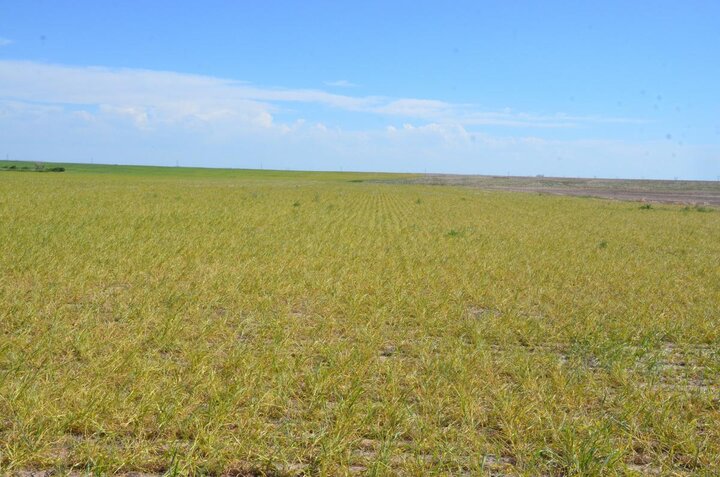A survey of wheat fields in the Nebraska Panhandle on May 15-16 found only trace levels of stripe rust and low levels of tan spot. However, wheat streak mosaic was widespread with severity ranging from mild in many fields to moderate even in fields that looked green on the top of the canopy (Figures 1 and 2) to severe in some fields (Figures 3 and 4).
The severely affected fields were in the southern Panhandle in an area that had pre-harvest hail last summer. This pre-harvest hail shattered wheat grain that germinated into volunteer wheat before harvest. Wheat curl mites which transmit wheat streak mosaic moved onto the volunteer. The most severely affected fields are in areas where the volunteer was not controlled.



Apart from volunteer wheat, other factors may have played a role in the widespread occurrence of wheat streak mosaic which has been observed in the eastern part of the state as well, and in areas where there is no evidence of volunteer wheat. One factor is the mild temperatures that prevailed last fall and winter. During a prolonged fall with above normal temperatures as in 2016, wheat curl mites as well as the virus remain active, reproduce, and spread for a longer time and at higher levels compared to a normal fall. As a result fall-planted wheat, especially that which was planted early, becomes heavily infested with mites and the virus builds up to high levels, causing severe damage. (Engage with this interactive animation to see how wheat streak mosaic virus spreads from one field to the neighbors' fields.)
Another factor that may have contributed to the widespread occurrence of wheat streak mosaic is the existence of grassy weeds and wild grasses that are hosts to both the mites and the virus. When environmental conditions are favorable to the survival and reproduction of the mites and the virus, these weeds and grasses can become a significant source in addition to volunteer wheat.
This video explains the plant "green bridge" that supports migration of the wheat curl mite from growing plants to the next wheat crop and includes interviews with Cody Creech, extension dryland cropping specialist at the Panhandle REC, and Stephen Wegulo, extension plant pathologist for wheat. (A graduate project of Lindsay Overmyer)
Symptoms of wheat streak mosaic can be exacerbated in the presence of one or two additional viruses transmitted by wheat curl mites. These viruses are Triticum mosaic virus and High Plains virus. University of Nebraska-Lincoln research has shown that Triticum mosaic virus often occurs with wheat streak mosaic virus. When both viruses occur in the same plant, symptoms are more intense and yield loss is higher than when either virus is present alone.
Management
Wheat Streak Mosaic
Virus diseases cannot be controlled once they occur. If your field is severely impacted by wheat streak mosaic, consider planting it to a spring crop. For next year’s wheat crop, it will be critical to control any volunteer wheat that emerges before wheat harvest.
Fungal Diseases
Although stripe rust levels have generally been low statewide, the current wet weather can cause it to develop to damaging levels. With warmer temperatures as the growing season progresses, leaf rust is likely to increase. Fungal leaf spot diseases (especially Septoria leaf blotch) and powdery mildew have been developing to moderate to severe levels in some fields. Given the current wet weather and based on the level of disease in a field determined from scouting, consider applying a fungicide to protect the flag leaf.
Wheat in some fields is already at the full heading or flowering stage. Note that some fungicides cannot be applied once flowering begins or after Feekes growth stage 10.5 (Table I). If wheat is flowering, consider applying a fungicide that can control Fusarium head blight (scab). Such a fungicide will also have excellent efficacy on foliar fungal diseases. Information on fungicide application instructions and restrictions, including the pre-harvest interval, is indicated on the label.

